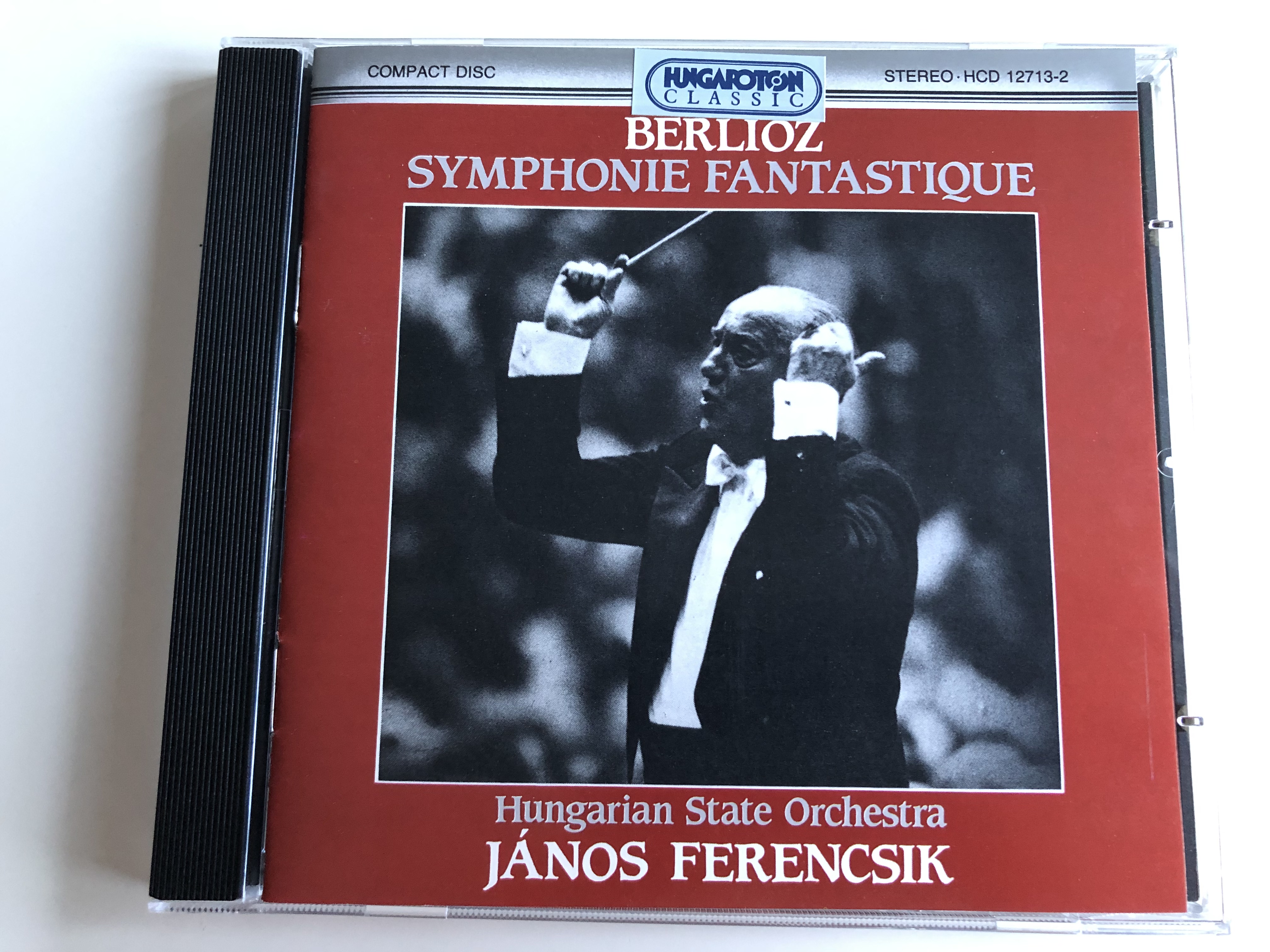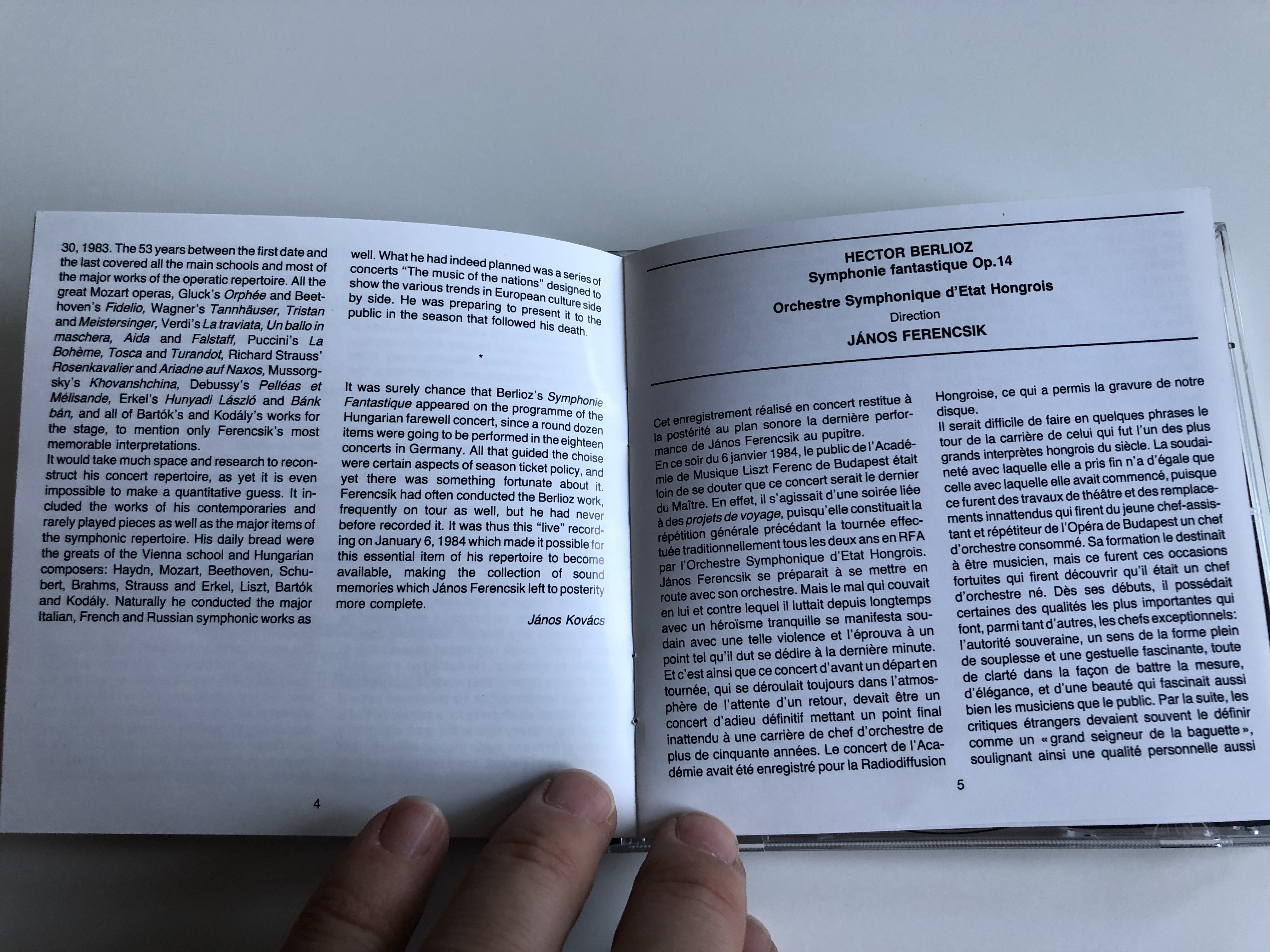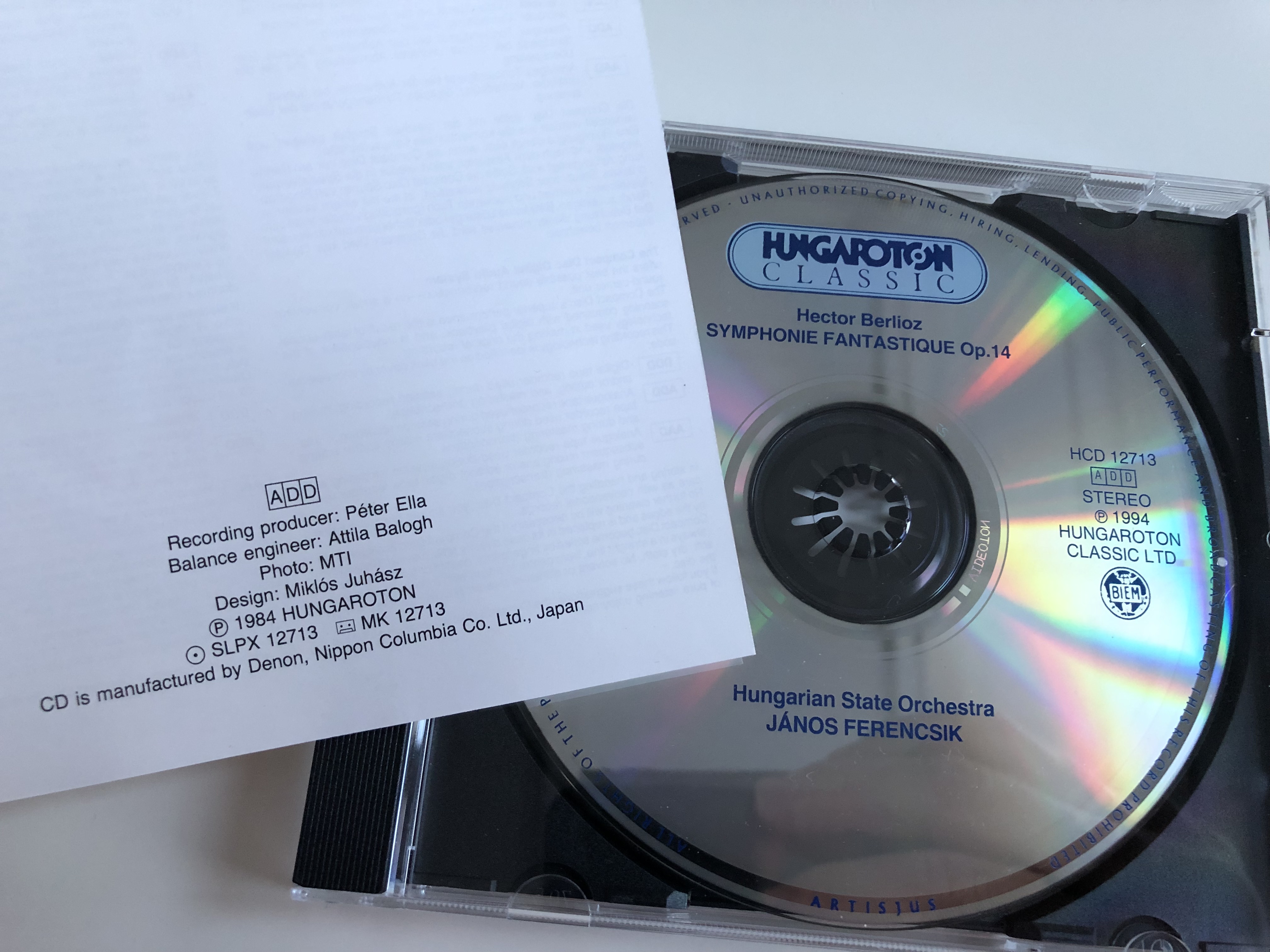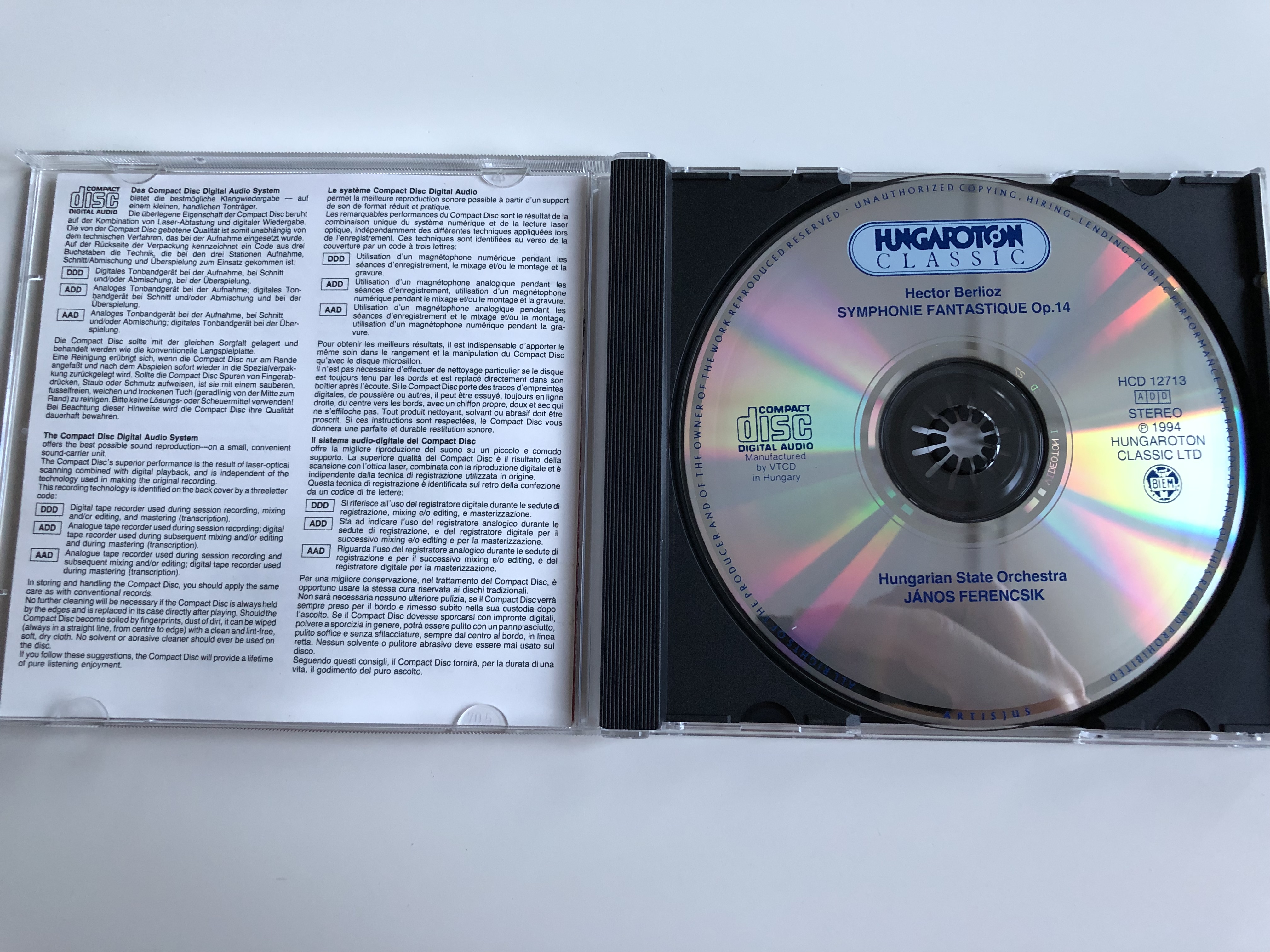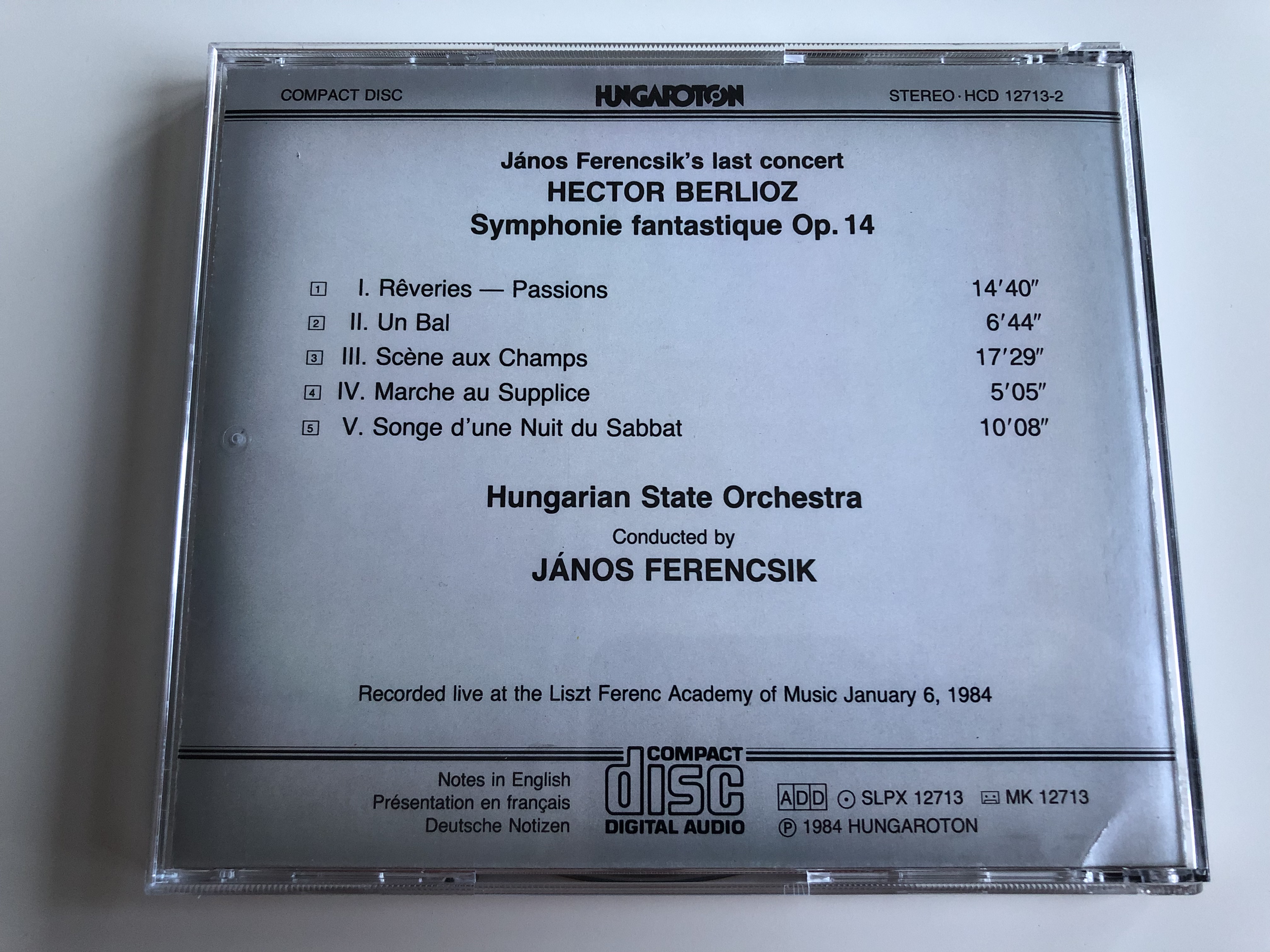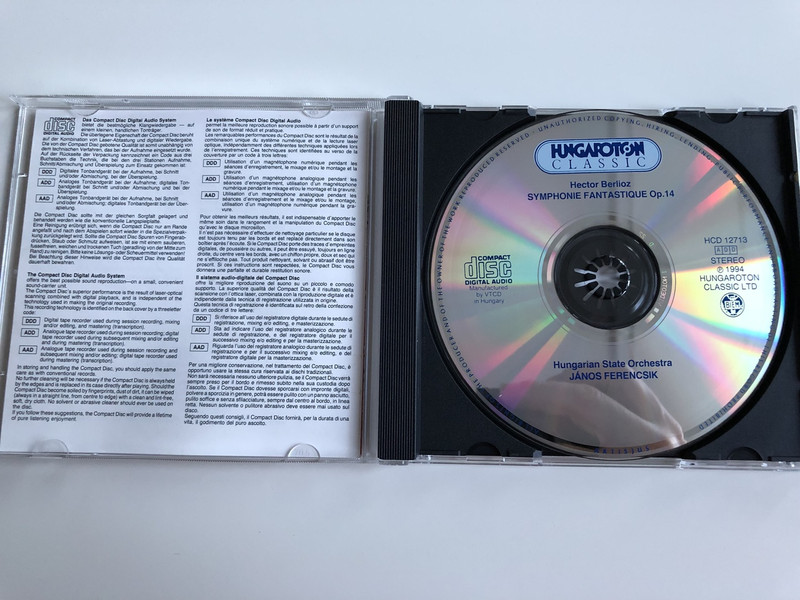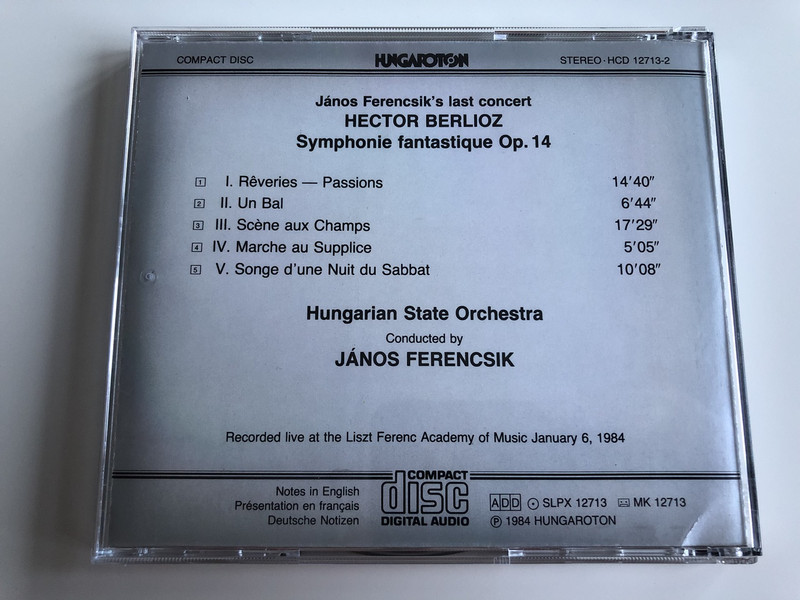Description
Hector Berlioz, Symphonie Fantastique, Hungarian State Orchestra Conducted by János Ferencsik
Hungaroton Classic
HCD12713-2 AUDIO CD 1984 ADD
- ASIN : B000050QHC
Notes in English, French, German
Label: Hungaroton – HCD 12713-2
Format: CD, Album
Country: Hungary
Released: 1984
Genre: Classical
Style: Romantic
Tracklist:
János Ferencsik's Last Concert
Hector Berlioz - Symphonie Fantastique Op. 14 (Episodes De La Vie D'Un Artiste)
I. Rêveries - Passions: Largo - Allegro Agitato E Appassionato Assai 14:40
II. Un Bal: Valse, Allegro Non Troppo 6:44
III. Scène Aux Champs: Adagio 17:29
IV. Marche Au Supplice: Allegretto Non Troppo 5:05
V. Songe D'Une Nuit Du Sabbat: Larghetto - Allegro 10:08
- Recorded At – Franz Liszt Conservatory, Budapest
- Manufactured By – Denon
- Phonographic Copyright (p) – Hungaroton
- Record Company – Artisjus
- Conductor – János Ferencsik
- Design – Miklós Juhász
- Engineer [Balance Engineer] – Attila Balogh
- Liner Notes – János Kovács
- Photography By [Photo] – MTI
- Producer [Recording Producer] – Péter Ella
Recorded live at the Liszt Ferenc Academy of Music January 6, 1984.
- Matrix / Runout: C37-7567
- Matrix / Runout: 1A1O-69
Symphonie fantastique: Épisode de la vie d'un artiste ... en cinq parties (Fantastical Symphony: An Episode in the Life of an Artist, in Five Parts) Op. 14, is a program symphony written by the French composer Hector Berlioz in 1830. It is an important piece of the early Romanticperiod. The first performance was at the Paris Conservatoire on 5 December 1830. Franz Liszt made a piano transcription of the symphony in 1833 (S. 470).
Leonard Bernstein described the symphony as the first musical expedition into psychedelia because of its hallucinatory and dream-like nature, and because history suggests Berlioz composed at least a portion of it under the influence of opium. According to Bernstein, "Berlioz tells it like it is. You take a trip, you wind up screaming at your own funeral."
In 1831, Berlioz wrote a lesser-known sequel to the work, Lélio, for actor, orchestra and chorus.
Louis-Hector Berlioz (/ˈbɛərlioʊz/; French: [ɛktɔʁ bɛʁljoz]; 11 December 1803 – 8 March 1869) was a French Romantic composer. His output includes orchestral works such as the Symphonie fantastique and Harold in Italy, choral pieces including the Requiem and L'enfance du Christ, his three operas Benvenuto Cellini, Les Troyens and Béatrice et Bénédict, and works of hybrid genres such as the "dramatic symphony" Roméo et Juliette and the "dramatic legend" La damnation de Faust.
The elder son of a provincial doctor, Berlioz was expected to follow his father into medicine, and he attended a Parisian medical college before defying his family by taking up music as a profession. His independence of mind and refusal to follow traditional rules and formulas put him at odds with the conservative musical establishment of Paris. He briefly moderated his style sufficiently to win France's premier music prize, the Prix de Rome, in 1830 but he learned little from the academics of the Paris Conservatoire. Opinion was divided for many years between those who thought him an original genius and those who viewed his music as lacking in form and coherence.
At age 22 Berlioz fell in love with the Irish Shakespearean actress Harriet Smithson, and he pursued her obsessively until she finally accepted him seven years later. Their marriage was happy at first but eventually foundered. Harriet inspired his first major success, the Symphonie fantastique, in which an idealised depiction of her occurs throughout.
Berlioz completed three operas, the first of which, Benvenuto Cellini, was an outright failure. The second, the huge epic Les Troyens (The Trojans), was so large in scale that it was never staged in its entirety during his lifetime. His last opera, Béatrice et Bénédict – based on Shakespeare's comedy Much Ado About Nothing – was a success at its premiere but did not enter the regular operatic repertoire. Meeting only occasional success in France as a composer, Berlioz increasingly turned to conducting, in which he gained an international reputation. He was highly regarded in Germany, Britain and Russia both as a composer and as a conductor. To supplement his earnings he wrote musical journalism throughout much of his career; some of it has been preserved in book form, including his Treatise on Instrumentation (1844), which was influential in the 19th and 20th centuries. Berlioz died in Paris at the age of 65.
János Ferencsik (18 January 1907 – 12 June 1984) was a Hungarian conductor.
Ferencsik was born in Budapest; he actively played music even as a very young boy. He took violin lessons and taught himself to play the organ. He studied at the National Conservatory of Music in Budapest, where his major subjects were organ performance and composition. He joined the Budapest State Opera at the age of twenty, where he was engaged as a rehearsal coach. In this capacity he took part in the Bayreuth Festival in 1930-31.
At Bayreuth, he assisted Arturo Toscanini, an experience which was to be of decisive importance for the remainder of his career. Between the two world wars, he studied in Budapest under such conductors as Arturo Toscanini, Bruno Walter, Felix Weingartner and Wilhelm Furtwängler.
Ferencsik's international career began in 1937. By the end of the 1930s, he became one of the Hungarian Opera's leading conductors. He conducted the farewell concert of Béla Bartók and Ditta Pásztory-Bartók in 1940 in Budapest, just before Bartók had left the continent. His artistic career came to full fruition after 1945, as he was appointed General Music Director of the Budapest Opera, Principal Conductor of the Hungarian National Philharmonic Orchestra in Budapest and, from 1960 until 1967, and the Conductor Chairman of the Budapest Philharmonic Orchestra. From 1948 until 1950, Ferencsik was principal guest conductor of the Vienna State Opera, he was guest conductor of the Los Angeles Philharmonic, and toured widely abroad, conducting on every continent with the exception of Africa,
Ferencsik was a friend of Hungarian composers László Lajtha, Béla Bartók and Zoltán Kodály and was known for his interpretations of their works. Among his many recordings are two of Kodály's Székelyfonó. Notable students include Alexander Raichev.
Hungarian State Orchestra
Profile: Founded in 1923 as the Metropolitan Orchestra. Later the name was changed to Hungarian National Philharmonic Orchestra
For the Hungarian State Opera Orchestra, please use ANV of Magyar Állami Operaház Zenekara
Aliases: Hungarian National Philharmonic Orchestra
Members: Ferenc Szucs, László Szilvásy
A Fantasztikus szimfónia (Symphonie fantastique), alcíme szerint Epizódok egy művész életéből (Épisodes de la vie d'un artiste) Hector Berlioz Op. 14-es, öttételes zenekari műve.
Programzenei alkotás, a mű különlegessége az „idée fixe”, a rögeszmésen vissza-visszatérő vezérmotívum, ami mindig új hangulatot, érzelmet kelt a hallgatókban.
A darabhoz Berlioz részletes mesét (programot) írt, ami szerint a zenemű egy szerelmes fiatal művész álomszerű látomásairól, képzeletbéli kalandjairól szól. Ezzel a művel született meg a „romantikus szimfónia”, a szimfonikus költemények előfutára.
A szimfóniát 1830-ban mutatták be Párizsban, azóta a hangversenyek népszerű darabja világszerte, hangfelvételek sora jelent meg róla a legnevesebb karmesterek és szimfonikus zenekarok közreműködésével.
A tételek ismertetése a Berlioz által írt program szerint történik. A leírás szövegét Berlioz ezzel a mondattal kezdte: „A zeneszerzőnek az volt a célja, hogy egy művész életének különböző jeleneteit ábrázolja, amennyire ezeket zenében ki lehet fejezni.”
1. Álmok, szenvedélyek (Rêveries – Passions). Largo – Allegro e apassionato assai.
A szerző feltételezi, hogy egy fiatal muzsikus, aki attól a lelki bajtól szenved, amit egy híres író üres szenvedélyeknek nevezett, először pillant meg egy nőt, aki az ideális lénynek mindazt a báját egyesíti magában, amelyről a fiatalember képzelegve álmodott, és eszeveszetten beleszeret. Egyedülállóan különös, hogy a drága képmás soha nem jelenik meg másképp a művész képzeletében, mint egy zenei gondolattal összekapcsolódva, amelynek a karaktere szenvedélyes, de nemes és visszafogott, olyan, mint amilyennek szerelme tárgyát képzeli. Ez az emlékeztető dallam modelljével együtt kettős rögeszmeként követi szüntelenül. Ez az oka, hogy az első Allegrót kezdő dallam folytonosan, a szimfónia valamennyi tételében megjelenik. A szimfónia első tételének „témája” az átmenet e melankolikus álmodozás lelkiállapotából, amelyet a céltalan öröm rohamai szakítanak meg, az őrült szenvedélyig, dühkitörésekkel, féltékenységgel, ellágyulásokkal, könnyekkel, vallásba menekülő vigaszokkal.
2. Bál (Un Bal). Valse. Allegro non troppo.
A művészt az élet legkülönbözőbb körülményei között látjuk viszont: itt egy ünnepi forgatag közepében, ahol szintén megjelenik előtte a kedves képmása, és felkavarja a lelkét.
3. Jelenet a mezőn (Scène aux Champs). Adagio.
Egy este vidéken találja magát, a távolban két pásztor a „ranz des vaches” (svájci népdal) dallamával beszélget egymással. Ez a pasztorális kettős, a jelenet helyszíne, a fák gyengéd susogása az enyhe szélben és néhány reményteli gondolat, amelyet nem oly régen dédelget, együtt szokatlan nyugalmat ad a szívének, és derűsebb színezetet a gondolatainak. Fellélegzik magányában, azt reméli, csakhamar nem lesz már egyedül… De ha csalódna!… A reménynek és a félelemnek ez a keveréke, ezek a boldogságról szőtt gondolatok, amelyeket néhány sötét sejtelem zavar meg – ezek az Adagio témái. A végén az egyik pásztor újra belekezd a ranz des vaches-ba, de a másik nem felel többé… Távoli mennydörgés… Magány… Csönd…
4. Menet a vesztőhelyre (Marche au Supplice). Allegretto non troppo.
A művész, miután megbizonyosodott, hogy szerelme viszonzatlan, ópiummal megmérgezi magát. A narkotikum dózisa kevés ahhoz, hogy halált okozzon, de mély álomba süllyed tőle, amit a legrettenetesebb látomások kísérnek. Azt álmodja, hogy megölte azt, akit szeretett, hogy elítélték, a vesztőhelyre vezették, ahol részt vesz a saját kivégzésén. A menetoszlop néha komor és szilaj, máskor meg ragyogó és ünnepélyes induló hangjai mellett közeledik, a súlyos léptek tompa hangját minden átmenet nélkül a legzajosabb kiáltások követik. Az induló végén ismét megjelenik az idée fixe első négy hangja, ezúttal, mint a szerelem utolsó gondolata, amelyet a végzetes csapás félbeszakít. Majd dobpergés, komor gyász, a kivégzést lefújják.
5. Boszorkányszombat (Songe d’une Nuit du Sabbat). Larghetto – Allegro.
A művész egy boszorkányéjen látja magát, árnyak, boszorkák, mindenfajta szörnyek rettentő csapatának közepette, akik mind az ő temetésére gyűltek össze. Furcsa zajok, sóhajtások, kacagások, távoli kiáltások, amelyekre mintha más kiáltások felelnének. A szeretett dallam újból megjelenik, de elvesztette nemes és félénk jellegét; most már csupán táncnóta, aljas, triviális és groteszk. Íme a szerelem, seprűnyélen táncol. Ő is eljött a boszorkányszombatra… Örömteli ordítozás fogadja érkeztét… A diabolikus orgiába veti magát… Megszólal a lélekharang, majd a Dies irae (a gyászmise Utolsó Ítéletről szóló szekvenciája gregorián dallama) burleszk-paródiája hangzik föl. Ezután vad erővel tör ki a boszorkányéj táncforgataga. Végül együtt hangzik a boszorkánytánc és a Dies irae.
Ferencsik János, Magyar Állami Hangversenyzenekar
1. I. Rêveries - Passions (Largo - Allegro agitato e appassionato
2. II. Un bal (Valse, Allegro non troppo)
3. III. Scène aux Champs (Adagio)
4. IV. Marche au Supplice (Allegretto non troppo)
5. V. Songe d'une Nuit du Sabbat (Larghetto - Allegro)
